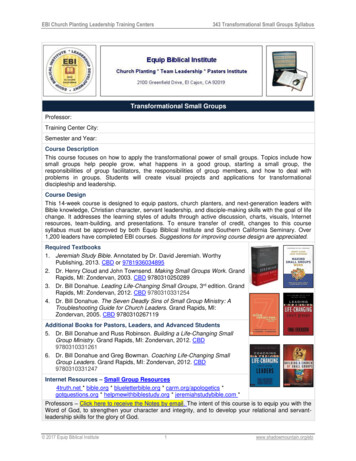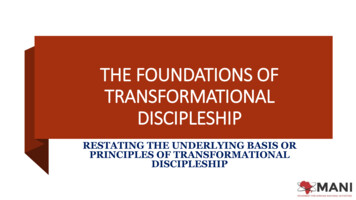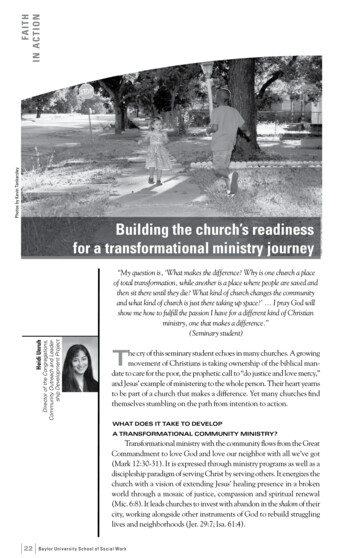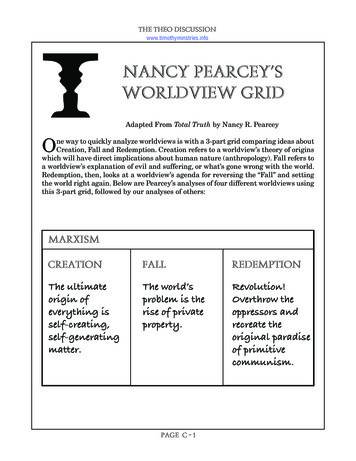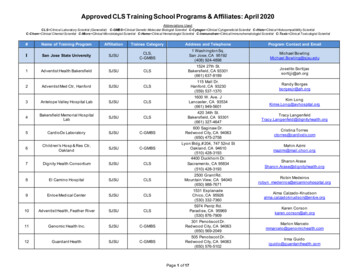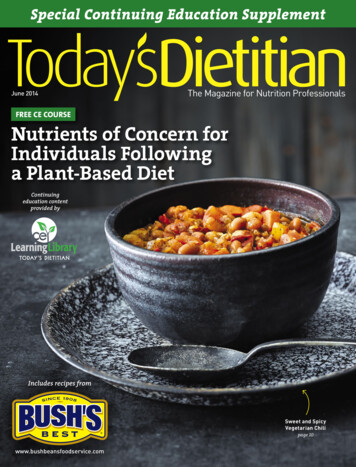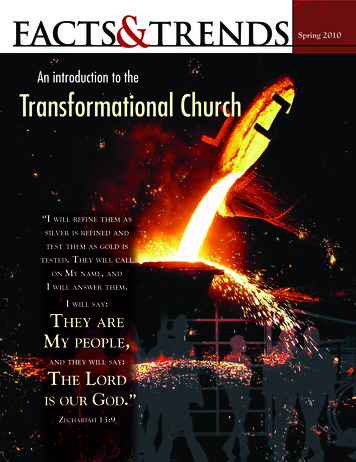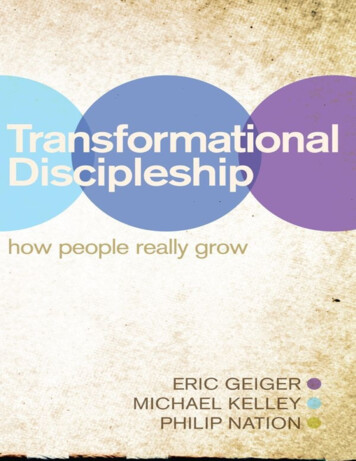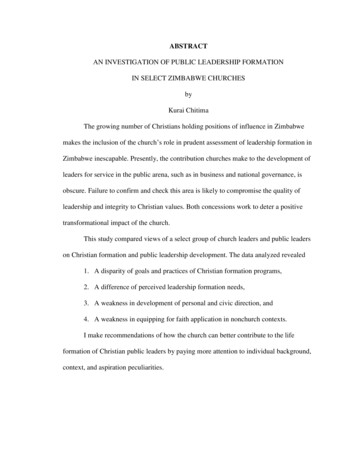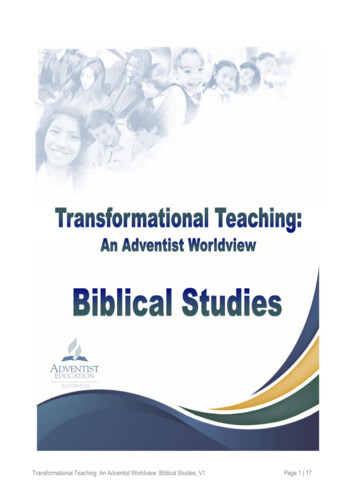
Transcription
Transformational Teaching: An Adventist Worldview: Biblical Studies V1Page 1 17
INTRODUCTIONThis curriculum framework is a brief statement that provides the foundational worldview from which an Adventistteacher delivers the Australian National Curriculum. It is a concise statement of principles, values and threadsthat undergird and guide what we consider to be real, true and good. This worldview is shaped and permeatedwith our belief that Jesus is “the Way, the Truth, and the Life.” John 14:6.We also believe strongly that each teacher must teach from within their own authentic Christian journey and thattheir experiential relationship with Jesus will permeate all they say and do. This framework endorses the notionthat rather than being Christians who happen to teach, we are wanting to teach Christianly. We wish to reveal aGod who loves unconditionally.“To think Christianly is to accept all things with the mind as related, directly or indirectly, to man’s eternal destinyas the redeemed and chosen child of God.” Harry Blamires, The Christian Mind: How Should a ChristianThink?, p. 44Teaching is more than imparting information. Effective Christian teaching is transformational. It will takeRomans 12:1-2 as its focus and try to nurture a discipleship response to God’s love in the lives of our students.This provides the basis for the term “threads” used in the Values and Action Response sections. ‘Threads’ aresimply the qualities or characteristics we desire as responses from our students. They help provide cohesionand linkage to everyday living. These Action Responses, like Values, will often overlap in various subjectareas, and provide a discipleship response to God’s love.This document is intended to be practical and succinct with a clear focus on the transforming role that theAdventist teacher can play in the lives of their students. It contains: A challenge to maximise the transforming teachable moments.An overview Adventist curriculum statement.A subject-specific rationale followed by the objectives for that KLA.A section focused on just how values and action responses, with appropriate essential questions, canchallenge the teacher to maximise an Adventist worldview and seek transformational experiences fortheir students.Suggestions where the units from the Adventist Encounter Curriculum link with values and actionresponses. No sample units are provided in this document as all schools are provided with the unitsand resources to use from the syllabus.The Transformational Teaching documents are designed to assist teachers in being intentional in including anAdventist Worldview in their Learning Areas. The suggestions included in each framework can also supportteachers in achieving the following Adventist Identity Teaching Standards (Supplement to the AITSL NationalProfessional Standards for Teachers). Further elaborations of these standards can be obtained from yourprincipal or your Director of Education. They can also be found on the ASA website http://asa.adventist.edu.auADVENTIST IDENTITY TEACHING STANDARDSPROFICIENT STANDARD1.7 Understand how students learn about GodDesign and implement teaching programs to promote and support students’learning about God.2.6 Knowledge of the content of the Bible and its teachingsUse effective teaching strategies to integrate Bible stories and themes intospecific content in appropriate and meaningful ways.2.7 Reflect an Adventist WorldviewUnderstand and differentiate the various worldviews to integrate a genuineAdventist Christian Worldview into classroom and school activities.3.8 Integrate Faith and LearningPlan and implement effective strategies for the integration of Faith andLearning to engage students in their learning about God.Transformational Teaching: An Adventist Worldview: Biblical Studies V1Page 2 17
A CHALLENGEWhile these curriculum documents have been put forth as suggestions of how topics of faith, God, and valuesmight be interwoven into BIBLICAL STUDIES classes, anecdotal research indicates that when people are askedabout their “best" teacher, by far the most influential aspects for 70-80% of responses relate to the kind ofperson the teacher was, and how his/her personal faith and experience with God was talked about, lived,modelled and shared with students. This idea is backed by one Valugenesis report that recommends that sinceyoung people are wanting a deeper personal relationship with God, “church leaders need to consistently modellife lived in relationship to God, and teach that religion is basically a matter of relationships with God and fellowhumans rather than a system of beliefs or a code of behaviour.” With the current generation’s desire forauthenticity, they want to know how this ‘God thing’ works and to see how it is lived out in everyday life.EXAMPLES OF POWERFUL AND TRANSFORMING TEACHABLE MOMENTSIn STORIES, teachers share ways that God works and is at work through 1. Object lessons, metaphors, word pictures, illustrations2. Teachers or students provide own personal stories involving understandings of God, His intervention,His answers 3. Teacher exemplifies values in his/her own life which students might model – e.g. patience,perseverance, joy of learning, humility, wonder of God’s ways, fairness, equity, mercy, and grace for thechallenging students.In FAITH EXPERIENCES in which 1. Teachers and students have opportunity to share aspects of their personal walk with God with eachother (e.g. sharing with a student how God had directed your thinking in certain ways).2. Students and teachers explore ways of building relationships with other people through communitywork, cooperation and service.3. Class activities/assignments that include opportunities for students to communicate God’s messagethrough writing, speaking, audio-visual presentations and other appropriate ways.4. Whole-school events such as Chapel, special Weeks of Spiritual Emphasis, School Dedication Nightsall contribute to shaping the students’ faith.5. Students are able to participate in small-group events like after-school Bible studies and serviceactivities.In the SCHOOL SETTING, opportunities to acknowledge God exist in 1. What is written in words, official policies, documents, newsletters, and signage.2. What is visually displayed in terms of bulletin boards, displays, neat and tidy classrooms withoutrubbish on the floor, manicured lawns and gardens, large posters with a Bible text, inspirationalquotation etc3. The ‘hidden curriculum’ – what is ‘felt’ when one comes into the school – warmth, belonging, sharing;how discipline and deviant issues are solved, a caring community that looks out for each other andrallies around in disaster and need Transformational Teaching: An Adventist Worldview: Biblical Studies V1Page 3 17
CURRICULUM in an Adventist SchoolThis statement represents the heart of Adventist Curriculum in Australia, providing a context and orientation for thelearning areas that make up the full curriculum.Seventh-day Adventist education begins with recognition of the eternal, loving and personal God who has always existed,is all powerful, and is the source of all life, truth, beauty and what is of value. It is based on the premise that God hasprovided insights into His character and what He has created. It believes that as created beings, humans are dependenton God for such insights in order to know how to grow, function and develop in keeping with His ideal for mankind. Thisneed is because of humanity’s separation from God through sin, and God’s initiative in re-establishing a relationship withhumanity through the coming of Jesus Christ, the perfect expression of what God is like.Adventists believe that humans were created by God to be perfect and in His image, but people exercised their God-givenpowers of choice and rebelled against God. Mankind is now naturally depraved, dependent on the divine initiative of Godfor salvation and the restoration of former God-man relationships. Mankind’s true value is only found in his relationshipwith God and not in isolation from Him. This view asserts that an infinite God, through Christ, created this world as part ofa perfect Universe which He continues to sustain by His power, through the law He has ordained. Although createdperfect in God’s likeness, humanity’s free choice led to alienation from the Creator. This broken relationship resulted in afallen nature out of harmony with God, and a blighted creation. Through His infinite love, God instituted a plan of salvationthrough the life, death and resurrection of His Son, Jesus Christ. This plan provides for the restoration of a harmoniousrelationship between humanity and the Creator, and gives hope of eternal life.The curriculum in Adventist schools is seen as contributing to the restoration process towards God’s ideal. It is, therefore,a needs-based curriculum, covering a range of knowledge, skills, attitudes, behaviours and values through teaching andlearning experiences designed to facilitate holistic development – spiritually, mentally, physically, emotionally, creativelyand socially. It endeavours to provide this foundation through a comprehensive range of learning areas. These learningareas (or LAs) represent the various facets of God’s creation, how each aspect functions, and how created elementswithin them interrelate. Although they stand with their own distinctive form and character, and may be studied as such,they also allow for integration with one another, thus acknowledging holism in God’s created order. These learning areas,therefore, are like ‘windows’ in two senses – windows through which students may gain views of God’s character andaction, and windows of opportunity to respond to God in ways that reflect His character and the values that are part of HisKingdom.God’s design for enjoyment of a full and abundant life is realised in acceptance of His laws and values as revealed in theunselfish life of Christ and is expressed in His teachings. These values impact on all people’s cultural activities and reflecttheir relationship with God, other people and the natural world entrusted to their care as well as providing a foundation foran eternal life lived in God’s presence. Related aesthetic values shape their appreciation of beauty and creativity. Fromthis perspective, the development of Christian faith pervades all of life, so every activity within every learning area hasspiritual significance.Transformational Teaching: An Adventist Worldview: Biblical Studies V1Page 4 17
The Purpose of Teaching and Learning BIBLICAL STUDIES in an Adventist SchoolThe Bible is the portal by which students come to know God who is the central focus of the Christian life – “In Him we liveand move and have our being” Acts 17:28.Adventist Christians accept that humans can develop a relationship with God, when led by His Spirit. BIBLICAL STUDIESemphasises that Man's true value is only found in his relationship with God and not in isolation from Him. Commitmentand application are essential to gaining a vision of God in both Old and New Testaments, reflecting on the Christ of theGospels and allowing His Lordship and Presence in their lives. Ultimately, BIBLICAL STUDIES should encourage a soundunderstanding of the Bible and emphasise how to apply biblical principles to one’s life.From Foundation to Year 10, this learning area is taught using the Adventist Encounter Curriculum which encourageseach student to experience a deep relationship with Christ. This curriculum is innovative, accepting and positive inapproach. It has been developed to show how spirituality is living out belief, how it is developed in relationships, how itgives meaning to life and how it brings about changes of one’s life direction. The Adventist Encounter Curriculum hasa focus on Spiritual Growth* and uses the Transformational Planning Framework**. (* and ** see Page 8 for more details.) Itsupports teachers in sharing a series of learning experiences with their students. Transformation is the goal.In the senior secondary years BIBLICAL STUDIES courses vary according to state curriculum requirements and emphasiseseveral Christian perspectives. These all need to be taught from an Adventist worldview. Units for Years 11 and 12 fromthe Adventist Encounter Curriculum are also available as an alternative to the state-endorsed courses.BIBLICAL STUDIES classes are where all students can encounter God through exploring stories of Bible events and themes,are provided with opportunities to develop a relationship with Him, are challenged to construct a set of personal Biblebased beliefs and are supported in putting these beliefs into practice in their own lives and through service activities.BIBLICAL STUDIES seeks to build for eternity.“And this is the way to have eternal life – to know you, the only true God,and Jesus Christ, the one you sent to earth.”John 17:3 NLTBIBLICAL STUDIES ObjectivesThe study of KLA in a Seventh-day Adventist school will *THE FOUR LENSESCREATIONTHE EThe SymbolThe FocusThe DescriptorKLAObjectivesThe meaning of aparticular learningconcept and God’spurpose.What went wrong becauseof rebellion?How to respond, usinglearning for God’s purposein everyday life.Points to the future when“all will be made new”i.e. present actions beingshaped by the future ideal.God created a perfectworld and intendedhumans to flourishand care for Hiscreation.God’s purpose forcreation was distortedby disobedience and, asa result, everything hasa fractured relationshipwith God.We have beenreconciled to God andredeemed throughChrist’s sacrifice.Christ is the example ofhow to live and respondto others and care forGod’s creation.When Christ returns,Creation will be restoredto what God intended.God has plans for aneternity with His people.This gives us hope forthe future.*Note: “Connecting Learners with God’s Big Story” from Christian Schools Australia, 2015. This book suggests four ‘lenses’ through which to view theworld. These align with our understanding of the Great Controversy and provide a useful tool to assist with integrating faith and learning.Transformational Teaching: An Adventist Worldview: Biblical Studies V1Page 5 17
Guidelines for BIBLICAL STUDIES in Adventist Schools AustraliaThe primary aim of Adventist education is to lead young people to Christ. It is through deep and considered engagementwith God’s word, the Bible, that they learn of Christ and the principles of His Kingdom. To achieve this goal in the marketplace of ideas that surround young people and their families in society it is vital that the key learning area of BIBLICALSTUDIES is core to each school’s academic program.God’s Word is to be at the heart of every Adventist school. Teachers skilled and passionate about sharing God’s wordare to be supported with appropriate resources and time allocations to ensure that young minds in our schools can knowChrist and form strong Biblical worldviews.For these reasons, the National Board of Education has endorsed these recommendations for implementation.Recommended that:1. The term BIBLICAL STUDIES be used to identify Bible classes from Foundation to Year 10.2. BIBLICAL STUDIES and the sharing of God’s Word is core of the academic program in all schools within AdventistSchools Australia. The Bible is the textbook for these classes.3. The required syllabus for BIBLICAL STUDIES from Early Childhood to Year 10 in Adventist Schools Australia is theAdventist Encounter Curriculum.a. When using the Adventist Encounter Curriculum, it is appropriate to adopt the program but adapt it tosuit the local situation.b. The Scope and Sequence of the Adventist Encounter Curriculum is to be followed but may requiremodification to suit the local circumstance and teaching style (e.g. using a two-year cycle for multi-gradeclassrooms etc.).c. Elements from each of the eight phases of the Transformational Planning Framework are to be includedwhen teaching each unit.d. The Outcomes / Achievement Standards of the Adventist Encounter Curriculum will be used toassess the units taught.e. BIBLICAL STUDIES will be reported on as a part of regular reporting processes.4. BIBLICAL STUDIES, or its equivalent ATAR subject is a mandated subject for all students in Years 11 and 12 inAdventist Schools.5. For NSW, the BOSTES-Stage 6 endorsed course, BIBLICAL STUDIES, be an interim option to Studies of Religionuntil Encounter Years 11/12 is fully available.6. State-endorsed senior BIBLICAL STUDIES courses [Studies of Religion; Studies of Religion and Society / Texts andTraditions / Comparative Religions etc.] be offered on an ongoing basis. Further that all senior students berequired to complete at least a unit one course of sixty hours of study and that academically-able students besupported in studying a unit two level course which will involve another sixty hours of study.7. For schools offering Year 12 (two unit) Studies of Religion or its equivalent, the two religions studied in depth bea. Christianity and Judaism ORb. Christianity or Judaism plus one other world religion.8. Allocated minimum times for BIBLICAL STUDIES bea. For Early Learning settings daily using the Early Encounters with Jesus curriculum.b. For Foundation to Year 6 80 hours per year to include Adventist Encounter Curriculum lessonswith weekly Chapels and class worship times to be additional to these hours.c. For Years 7 to 10 100 hours per year to include Adventist Encounter Curriculum lessons withweekly Chapels and class worship times to be additional to these hours.d. For Years 11 and 12 100 hours (unless studying a 1-unit option) per year with class worships andChapel times to be additional to these 100 hours.Transformational Teaching: An Adventist Worldview: Biblical Studies V1Page 6 17
Philosophical UnderpinningsThe Community of Faith and Learning model developed by Adventist Schools Australia (Foundation – Year 12) explains theSpecial Character of Adventist Schools. It includes three domains – BELONGING, BELIEVING and BECOMING. The parallelmodel for Early Childhood Education and Care includes a fourth domain of BEING which aligns with governmentrequirements. Note that both these models include the domains of BELIEVING and BECOMING which are significantly impactedby the students’ involvement with the BIBLICAL STUDIES learning area and associated events at the school.Adventist Schools Australia has also chosen nine core VALUES based on 1 Corinthians 13. These VALUES are founded inLove and are demonstrated in Service. More details and implementation ideas are shared in the booklet “Values forAdventist Schools” available on the ASA website.Transformational Teaching: An Adventist Worldview: Biblical Studies V1Page 7 17
The Adventist Encounter Curriculum is underpinned by two philosophies.One is the Spiritual Growth model developed by Ben Maxson and this has greatlyinfluenced the Scope and Sequence of the program.The other is the Transformational Planning Framework which was developed by Lanelle Cobbin. Each of the units writtenfor Foundation to Year 12 uses this framework and is written with the intention of providing experiences during which thestudents may encounter Jesus and get to know Him – not just about Him.Transformational Teaching: An Adventist Worldview: Biblical Studies V1Page 8 17
The Early Encounters with Jesus syllabus, developed for use in all Early Childhood Education and Care centres, has asimpler planning framework. The 28 units in this program share familiar Bible stories andrelevant Bible messages while providing educators with a wealth of activities, resourcesand ideas to accompany the child-focussed curriculum, being guided by the students’capabilities and lines of enquiry.The Scope and Sequence for units in the Early Encounters with Jesus curriculum links the four domains with theconcepts of Grace, Community, Worship and Service. Centres are encouraged to use the curriculum in the way that bestsuits the needs of their current students. It can be used over a one-year cycle or as flexible, stand-alone units.Transformational Teaching: An Adventist Worldview: Biblical Studies V1Page 9 17
VALUES FORADVENTISTSCHOOLSLinking Values for Adventist Schools and Action ResponsesACTION RESPONSE(THREAD NUMBER)DESCRIPTION OF ACTIONRESPONSEBIBLICALFOUNDATIONKEY ESSENTIAL QUESTIONSFOR STUDENTSFURTHER QUESTIONSFOR TEACHERSAdapted from Transformation by DesignAdapted from Transformation by Design LOVE*LOVING GOD (1)PONDERINGCREATION (13)Students respond to God’slove by loving God and theirneighbour as themselves.Students contemplate boththe Creator and Hishandiwork and respond indelight and praise.Matt 22:37-39Matt 7:121 John 3:16;4:19Ps 19Rev 4:11Matt 6:25 -31 What does God’s love look like?How do we respond to God’s love?What does it mean to love God withall your heart, soul, mind andstrength?Where can we see the fingerprintsof God in creation?If God created the whole universe,why does He care about us? SERVICE* CARETAKINGEARTH (3)Students actively respond toGod’s call to carefullymanage all creation.IMITATINGHUMILITY (11)Students gratefully acceptGod’s grace and respond byhumbly serving Him.PRACTISINGHOSPITALITY (14)Students welcome andaccept others, and use theirgifts to embrace others intocommunity.UNDERSTANDINGVOCATION (22)Students discover thevocational task in which Godhas called them to serve.UNWRAPPINGGIFTS (23)Students enrich theirs andothers’ lives throughdeveloping and using theirgifts. Gen 1:28Ps 8:5-8Gen 2:15Rom 12:3Col 3:12-13John 13:12-171 Peter 4:8-10Heb 13:2-3Luke 14:12-14 Rom 12:4-81 Cor 4:4-11 What does obedient caretaking ofthe earth look like?How can we explore and make useof the world God has given uswithout spoiling it?What is Christian humility? Is it theopposite of pride?What is the cost of humility?Why should we spend time, moneyand effort on hospitality?How do we choose who to sharehospitality with?Why should we work? Shouldeveryone work?What is our ‘job’ as students?How do we reflect our Creator in ourwork?Am I truly unique?What do we learn about God fromthe gifts He gives us?Do all gifts enrich others? What does love look like in your classroom?How do we know God loves us besides Jesus’work on the cross?What opportunities are there for students toappreciate and express love for God in this unit / inyour classroom?How do you learn more of the nature andcharacter of God?How are you recognising God’s supreme artistry inCreation?While pondering creation, what do you learn aboutyour relationship with your Creator?How can you create opportunities for your studentsto ponder and respond in their own learning style?What whole-school/classroom/individual practicespromote caretaking earth?What do you need to stop doing in order to care forGod’s world?How do you affirm the hope in a loving andsustaining God in the face of a decaying anddespairing world?How can you foster a spirit of humility in yourclassrooms?How do you challenge students towards thoughtfulcontemplation of God’s love shown in the cross ofJesus?In what ways does humility stand in contrast to asense of rugged Australian identity andindividuality?Do all students feel welcome in your classrooms?How do you cultivate a spirit of generosity in yourstudents/teachers/school?If we are called by God to have a vocationalresponse, is there only one job for us?How are you preparing students for responsivediscipleship if/when they enter the workforce?How are your teaching practices helping touncover all different types of student gifting?EXAMPLESADVENTIST ENCOUNTERCURRICULA UNITSEE: God creates the worldEE: Baby Jesus is born.1A Salvation units each year.1D Easter units each year.4C Christmas units each yearK.1B Creation3.3B Jesus [Friend to the Friendless]6.2C Jesus’ Sacrifice7.1B Creation and the Fall7.2A The Cross8.3A Prodigal Son9.1A The Reality of God9.1B the Character of God9.3A The Gift of our World9.3B The Gift of the Sabbath9.3C The Gift of GraceEE: SamuelEE: Little Maid and CaptainNaamanEE: Zacchaeus meets JesusK.3A Jesus: Our Loving GiftK.4B Helpfulness2.1B God Protects Moses3.4A Generosity6.3B The Church Together6.3C The Church Grows7.4C Learning to Serve: Servingto Learn8.3C The Good Samaritan9.4A The Gift of Identity*Denotes the addition of Love and Service to the Values for Adventist Schools in the table below. Love overarches these values and Service is the active evidence of God’s Love and Kingdom Values. For the purpose of keeping this at theforefront in our thinking, Love and Service have been included along with the values listed below.Transformational Teaching: An Adventist Worldview: Biblical Studies V1Page 10 17
VALUES FORADVENTISTSCHOOLSACTION RESPONSE(THREAD NUMBER)EXCELLENCEDISCOVERINGPATTERNS (6)GETTINGWISDOM (9)REFLECTINGCREATIVITY (16)BUILDINGCOMMUNITY (2)COMPASSIONEMBRACINGDIVERSITY (7)EXPRESSINGWORDS (8)DESCRIPTION OF ACTIONRESPONSEStudents explore anddiscover God’s patterns anddesigns for delighting inand/or using for the benefit ofall.BIBLICALFOUNDATIONKEY ESSENTIAL QUESTIONSFOR STUDENTSFURTHER QUESTIONSFOR TEACHERSAdapted from Transformation by DesignAdapted from Transformation by DesignIsa 25:1Gen 8:22 Students go deeper thanunderstanding andknowledge to seek the insightof God.Prov 4:7James 1:5Prov 2:6-9Col 2:2,3Students praise God byreflecting their Creator inmaking expressive andinspiring things and ideas.Gen 1:26-27Ps 139:13-14Students are activecontributors and encouragersof others as the community isbuilt up.Col 3:12-14Rom 12:9-13Eph 6:7Col 3:22-25Students respect andcelebrate the built-indifferences between culturesand peoples given for theenhancement of all.Rev 7:9-10Gal 3:26-291 Cor 9:19-23Acts 17:24-27Students use words to buildup, make choices, andexpress life.Col 4:6Eph 4:29James 3:3-9 PURSUINGPEACE (15)Students bring healing andrestoration to people andareas of brokenness.2 Cor 13:11Col 3:15Rom 12:18SHOWINGMERCY (20)Students respond to God’smercy by likewise beingmerciful to others.Luke 6:36 Transformational Teaching: An Adventist Worldview: Biblical Studies V1 How can you identify a wise person?Does wisdom change with the times?Do we have to know God to be trulywise?Does everyone have the gift ofcreativity?How did God make me creative?How do we judge the value of anartwork?What makes a community?Who is our neighbour?Can we live without others?Why should we serve others with ourgifts?What good comes out of diversity?What do all cultures/people have incommon?What is the connection between whatwe think, what we feel and what wesay?How do you know when it is time tospeak and when it is time to besilent?If we promote ‘freedom of speech’does this mean that we can saywhatever we like?What is ‘world peace’ and is it ourgoal?Can all broken relationships berestored?Is there always a peaceful approachtowards conflict?What is mercy? How is it differentfrom justice and grace?Why does empathy encourage us toshow mercy? What do patterns and order reveal about thecharacter and nature of God?What patterns and structures are you deliberatelyshaping in your classroom?What is the relationship/connection betweenknowledge, understanding, experience, commonsense and insight?How are you ensuring that you are ‘in step with theSpirit’ so that you are a wise leader in yourclassrooms?How does artwork reflect the artist’s worldview?In what ways is reflecting creativity both service toGod and service to others?In what ways can your classroom be a richcommunity?How can you encourage your students to buildeach other up and to share burdens?What opportunities are you providing for studentsto enhance their local and global communities?How does the cross bring God’s people together incommunity?What opportunities are you giving students toexplore the richness of other cultures?How would you describe the culture of yourclassroom? Does it embrace diversity?How can there be unity in Christ where there aresuch vast differences in culture and people?As words are so powerful, how are you challengingyour students to use them to speak life intocommon situations?Are you educating your students on how to speaktruth in love, when to speak and when to keepsilent? What strategies are you using?Do your classrooms allow more enriching studentconversation rather than teacher talk?Do the processes in your school/classroompromote the resolution of broken relationships andthe restoration of peace?How can you be an agent of peace in a hurtingworld?How do you teach your students to forgive anoffence, and show mercy to others?EXAMPLESADVENTIST ENCOUNTERCURRICULA UNITSEE: God takes care of ElijahEE: The lost sheepEE: The lost sonEE: The lost coin1.4B – 5.4B; 6,4A The Bible2.2C God Provides for Needs2.2D God Provides His Presence4.1C David4.3C Teach Us to Live4.4A Godly Greatness5.1B Elijah5.1C Elisha5.2A Good Kings8.1A Joseph8.2B Elijah8.3E The Ten Bridesmaids9.1B The Character of GodEE: Abraham shares with LotEE: Baby MosesEE: Jesus calms the stormEE: The good SamaritanEE: The ten lepersK.3B Jesus TeachesK.3C Jesus HealsK.4A Friendliness1.3C Shining Lights2.3A Jesus Protects2.3B Jesus Provides2.3C Jesus Heals3.3A Jesus [Friend of Children]6.3A A Church is Born7.3A Transforming Whoever8.3B the Unforgiving Servant9.2B The Week of the Cross9.3C The Gift of GracePage 11 17
VALUES FORADVENTISTSCHOOLSACTION RESPONSE(THREAD NUMBER)DESCRIPTION OF ACTIONRESPONSEBIBLICALFOUNDATIONKEY ESSENTIAL QUESTIONSFOR STUDENTSFURTHER QUESTIONSFOR TEACHERSAdapted from Transformation by DesignAdapted from Transformation by DesignEXAMPLESADVENTIST ENCOUNTERCURRICULA UNITSHUMILITYEE: Jesus praysStudents respect andcelebrate the built-indifferences between culturesand peoples given for theenhancement of all.Rev 7:9-10Gal 3:26-291 Cor 9:19-23Acts 17:24-27 IMITATINGHUMILITY (11)Students gratefully acceptGod’s grace and respond byhumbly serving Him.Rom 12:3Col 3:12-13J
Teaching is more than imparting information. Effective Christian teaching is transformational. It will take Romans 12:1-2 as its focus and try to nurture a discipleship response to God’s love in the lives of our students. This provides the basis for the term “threads” used
